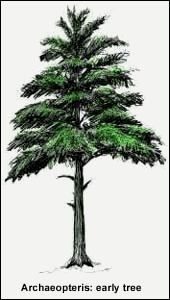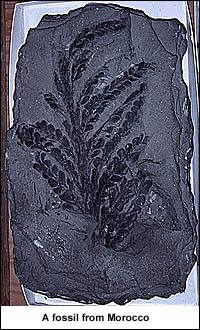
... LIVED "360-345 MILLION YEARS AGO"
We are all familiar with the diagrams of evolutionary
progression from a single-celled bacterium to multi-cellular animals, fish,
amphibia, reptiles, mammals, ape-men and modern man. Many creationist books
deal with absence of evidence for this gradual progression, also pointing
out the variety and complexity of life when it is first seen and the sudden
appearance of new designs in the fossil record. What about plant life? Do
we see the same patterns in the fossil record of plants as we do with animals?

Nature has recently reported new findings on Archaeopteris. This is not a misspelling of the name of the controversial reptile/bird fossil but "the earliest modern tree" to quote Meyer-Berthaud, Scheckler and Wendt (1999). Using conventional dating values for a comparison, it is not just the earliest, but it is unexpectedly early for such a complex form of life. It has been found widely in rocks dated as 370 million years old, in the Middle Devonian period, and has been reconstructed as a tree of up to 18m with a crown of spirally arranged fern-like leaves.
The recent interest has been sparked off by evidence of lateral branches that grew out more or less horizontally from the trunk as in modern trees. Several fragments of wood bore the bases of large branches at wide angles from the main trunk. In these samples were found undulating wood under the points of attachment and collars of extra wood surrounding the sides and upper surface. These are features typical also of modern trees and provide support for the weight of tree branches that extend out at a wide angle providing for compressional and tensional load bearing.
The complex design features of the horizontal branching, in addition to the advanced wood structure typical of conifers are a problem for the evolutionist. The tree is very early in the fossil record for such an advanced feature. It was "only" 50 million years before in conventional geological terms that the first plants with tissues that moved water around the plants (xylem) were found, but a much longer time, 230 million years until flowering plants appeared.
The first plants with conducting tissues were found in rocks of the Lower Silurian period, dated at 420 million years ago, in the class Rhyniopsida. Typically they were small plants a few centimetres high. They had stems that branched in three dimensions, by dividing more-or-less equally in two. They had no leaves and bore spores at the ends of the branches. There was a strand of water-conducting tissue, in the centre. These can be construed as "simple" plants but only in the same way as animals without vertebrates: good simple designs still around today! Psilotum is an example of a plant similar to the Rhyniopsida that can be found growing today in certain area of the world on the trunks of tree ferns, in rock crevices and also underground in some cases.
Then, about 395 million years ago, new features could be found fully developed: stomata (pores for the exchange of gases and water vapour), a cuticle to restrict water loss from the outside of the plant and small leaf-like objects on the stem. In the centre of the stems were water and food conducting tissues (xylem and phloem respectively), the same arrangement occurs in many plants today. Very rapidly, the main features of plant life were appearing.
Then, 375 million years ago, we find Archaeopteris, a fully formed tree with a taproot penetrating down into the soil. Together with other species in the class, it was the main component of the earliest forests, until they became extinct about 345 million years ago. The trunk is formed of wood typical of modern conifers with tracheids, water conducting cells, laid end-to-end (Stewart and Rothwell, 1993). It also contained strengthening materials such as lignin organised in such a way that the tree could stand upright and also to support large branches which grew out sideways. The branches originated from deep within the wood and are an entirely new feature in the fossil record of plants. The lignin in the xylem was present to provide rigidity to withstand the tension of carrying water up to the top leaves, rather like a straw needs to be rigid to prevent it collapsing as you suck. This was no small engineering achievement when the leaves were about 18 metres above the roots. The tree could also grow in breadth by division of a special layer of cells, providing both more wood to the inside and phloem to the outside as the tree grew bigger. The leaves were complex, divided up into many small leaflets and with spore bearing structures bearing micro- and megaspores on the upper surface. Plant life had changed out of all recognition, with many complex design features fully in place and many first appearing in the fossil record with the arrival of Archaeopteris and still the same in living trees today

Then, much later on, 229 to 270 million years later (141-100 million years ago in conventional geological terms), flowering plants first appeared in the fossil record. There are a number of new design features, but they are few compared with earlier developments. Flowering, with fully enclosed ovules and double fertilisation is first seen here. Wood vessels (tubes made up of cells laid end to end) are also found, which conduct water from the roots to the shoots as do tracheids in coniferous plants.
These plant fossils do not provide evidence for a gradual evolution of plant life from simple to complex. If evolution had occurred, then it would be expected that the various new features would appear in the fossil record at regular intervals. The reality is quite different. Early in the fossil record, plants of enormous complexity such as Archaeopteris are seen. Also, these complex life forms appear shortly after so-called simple forms that are more typical of damp, shaded environments where water is freely available and not much soil is needed for colonisation. Then a long period elapses before any new features are seen. Why did it take so long in evolutionary terms for flowering plants to evolve? We need to look elsewhere for an explanation of the distribution of fossil plants through the layers of the rocks.
Creation and the subsequent Flood of Noah, with vast depths of rock deposited as a result of that catastrophe, is an alternative that offers to make much sense of the evidence above. The differences in plant design to be found early in the record are compatible with colonisation of environments ranging from shallow waters to those where the conservation of water was increasingly important and conditions allowed greater upward growth and required specialised designs to transport water and nutrients around the plant.
Nancy M. Darrall (1999)
References:
Meyer-Berthaud, B. Scheckler, S. E. and Wendt, J. (1999)
Archaeopteris is the earliest known modern tree. Nature, 398,
700-701.
Stewart, W.N. and Rothwell, G.W. (1993) Paleobotany and
the Evolution of Plants.

